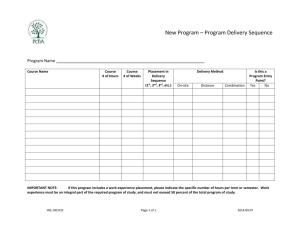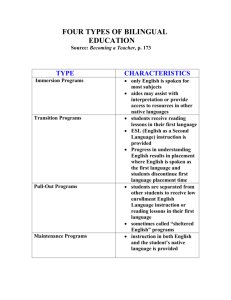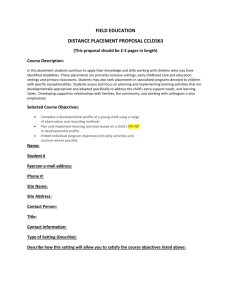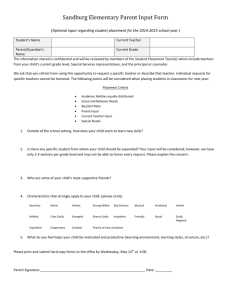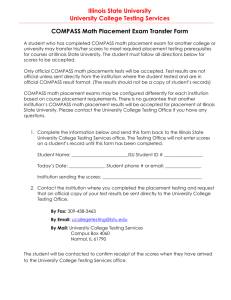Our old-old system English curriculum
advertisement
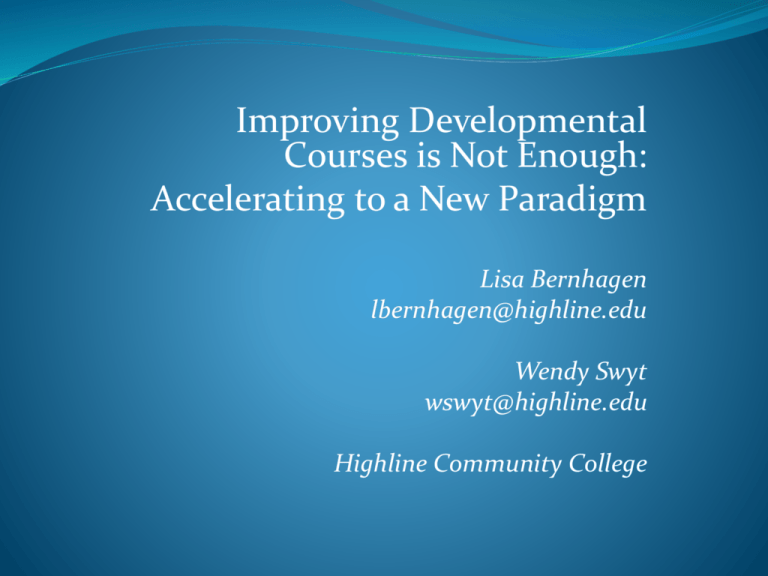
Improving Developmental Courses is Not Enough: Accelerating to a New Paradigm Lisa Bernhagen lbernhagen@highline.edu Wendy Swyt wswyt@highline.edu Highline Community College Our old developmental sequence… English 30: Writing the Sentence English 60: Writing the Paragraph English 91: Writing the Essay • COMPASS Placement (Score of 0-11 placed in English 71) • ESL and native students mixed at all levels • English 71 and 81 were frequently combined in one course because COMPASS placement was muddled. • In English 71 and English 81, instructors faced an unwieldy range of students…they complained it was hard to teach the course effectively…it was unclear what the courses were supposed to do and for whom. We changed the curriculum and placement. We thought we were fabulous… English 71 •Paragraph responses “English For Nonnative •ESL COMPASS Placement Speakers” •ReWrit 71: Linked to Reading 71 English 81 “Writing Skills” English 91 •Multi-paragraph responses •ReWrit 81: Linked sections for ESL students to Reading 81 •ReWrit 81: ESL COMPASS •English 81: Regular COMPASS • COMPASS and ESL “College Preparatory COMPASS placement • ATD intervention Writing” 2010: We realized that we were not… The pipeline effect Multiple exit points Acceleration National Data on the Pipeline Effect Students taking Remedial Reading courses From Referral, Enrollment, and Completion in Developmental Education Sequences in Community Colleges (CCRC Working Paper No. 15). By: Thomas Bailey, Dong Wook Jeong & Sung-Woo Cho. December 2008. New York: Community College Research Center, Teachers College, Columbia University. (Revised November 2009). Student’s initial placement % of students who successfully complete college level gatekeeper course in subject One level below college 42% Two levels below college 29% Three levels below college 24% …students who are referred to developmental courses two or three steps below college-level rarely complete introductory college courses and are even less likely to complete degrees. Bailey, Thomas. (February 2009). Rethinking Developmental Education. CCRC Brief. Community College Research Center. Teachers College, Columbia University. Our pipeline English 71 •Paragraph responses “English For Nonnative •ESL COMPASS Placement Speakers” •ReWrit 71: Linked to Reading 71 English 81 “Writing Skills” English 91 •Multi-paragraph responses •ReWrit 81: Linked sections for ESL students to Reading 81 •ReWrit 81: ESL COMPASS •English 81: Regular COMPASS • COMPASS and ESL “College Preparatory COMPASS placement • ATD intervention Writing” Exit Points… Will the student pass English 71? Will the student go on to English 81? Will the student pass English 81? Will the student go on to English 91? Will the student pass English 91? Will the student go on to English 101? Will the student pass English 101? More exit points = less chance of a student making it to and through English 101. Our Own Pipeline Data Initial placement in developmental English Enrolled in English 101 (data shows enrolled) English 91 67% English 81 47% English 71 32% …the costs of remediation, for both society and student, outweigh the benefits. -- Thomas Bailey Bailey’s recommendations: 1. Rethink assessment, focusing on understanding what students need in order to be successful in college rather than simply concentrating on placement within the sequence of a curriculum. 2. Abandon the dichotomy between developmental and college-ready students for a wide range of students above and below current developmental cutoff scores by opening college level courses to more students and by incorporating academic support assistance into college level courses. 3. For those students whose skills are so weak that they could not be successful even in augmented college-level courses, explicitly work to minimize the time necessary to prepare students for entry into those courses. Bailey, Thomas. (February 2009). Rethinking Developmental Education. CCRC Brief. Community College Research Center. Teachers College, Columbia University Acceleration Models: Ways to Shorten the Pipeline Mainstreaming Place students directly into college level with support (Baltimore, HCC) By-pass dev ed courses bridge courses, high school transcript placement, placement prep/retake (Seattle CC’s) Compression Offer content of two courses compressed into one quarter Curricular redesign Change sequence and structure (TCC, Chabot) Embedded learning Dev ed courses linked to college level “content”, I-BEST Accelerated Learning Project (ALP) Community College of Baltimore County Students placing into the course below College English are mainstreamed into a College English class. In each ALP section, there are 8 “dev ed” students with 12 “regular” English 101 students. Rather than taking English 101 as 3 credits (on a semester system), the “dev ed” students enroll for 5 credits. The 8 students meet separately with the same instructor in support course each week (2 credits). Completion statistics for college level English Non-accelerated sequence: 40% Accelerated course: 75% Chabot Community College: Open Access Developmental English At Chabot College in California, any student scoring below college level English on their placement exam (Accuplacer) can take an accelerated four credit pre-college course instead of the traditional 8-credit two semester sequence. “Open Access” college prep Completion statistics for college level English Non-accelerated sequence: 28-34% Accelerated course: 52-57% Highline CC: What we are doing English 101 combined with extra support in 10-credit course. Though students get 10 credits and a grade in 101 and 91 at the end, this is not a compression model. Students work on English 101 assignments and readings Support time is used for just-in-time remediation: what do students need to do the readings and assignments? Completion statistics for college level English Non-accelerated sequence: 56% Accelerated course: 79% In our own context What allowed us to do this: AtD intervention Supportive administration: pilots are encouraged, institutional researcher on board Faculty experienced in both pre-college and college level writing What challenges we face: Placement Historical political structures: a separate reading department Some instructors who teach 71 and 81 are wedded to the 3-level pipeline, despite the data about attrition. Our computer system (registration, transcripts, degree audit) In your context… Questions to address in your small group: 1. What conversations need to happen on your campus to make acceleration work? 2. What are the strengths on your campus that might help with implementing acceleration? 3. What are the challenges you will face in shortening the pre-college pipeline at your own institution? Our results so far… Instructors are challenged, excited, galvanized Students are passing English 101 at a higher rate than “regular English 101 students” (79/100 versus 76/100) We are rethinking our entire sequence Out of every 100 students … 90 retained in 091 •(90% retention rate) LOSE 79 pass 091 (2.0+) 10% •(88% pass rate) 67 enroll in 101 within 3 years •(85% enrollment rate) LOSE 60 retained in 101 15% •(90% retention rate) LOSE 56 pass 101 (2.0+) Office of Institutional Research, x3205 7/31/2012 10% • (93% pass rate) Accelerated Pedagogy: Eng 101 with support (10 credits; one quarter). 92 retained in 101 with support •(92% retention rate) 83 pass the support (2.0+) •(90% pass rate) 79 pass Engl 101 (2.0+) Office of Institutional Research, x3205 7/31/2012 •(86% pass rate) Pipeline 100 start in English 91 No Pipeline 100 start in Eng 101 with support 41% increase in the college course pass rate (23 percentage points). 56 pass Eng 101 (2.0+) Modified 10/10/12 from the Office of Institutional Research, created 7/31/2012 79 pass Eng 101 (2.0+) How did students do in gatekeeper courses after Eng 101? 41% MORE students make it into gatekeeper courses from Eng 101 with support than 91, 101; 5.3% MORE than from Eng 101. Eng 091, then 101 (n=2,815) (56% complete) Eng 101 (n = 10,293) (76% complete) Eng 101 with support (n=340) (79% complete) COMM 101 ENGL 205 PSYC&100, PSYCH100 SOC 110, SOC 101 Median Median Median Median 2.9 2.7 2.1 3.5 3.1 3.0 2.5 3.4 2.5 3.1 2.1 3.2 Acceleration exposes and undermines many assumptions of developmental instruction: Placement, though not perfect, correctly indicates where students “belong” in the sequence of pre-college courses. We must front-load skills before students get to the college level stuff – e.g. they first need to write clear sentences, then paragraphs, then essays. Acceleration: Big ideas High challenge, high support. Meaningful and integrated with college content Outcomes measure college-readiness, not next-step readiness. Acceleration doesn’t mean “faster”; it means deeper and better. Principles for Accelerated Pedagogy-Katie Hern, Chabot College #1: Engages students in intellectually challenging experiences that develop the most essential skills and ways of thinking required in college. #2: Attends to the affective issues that get in the way of students’ learning and success. #3: Facilitates an ongoing metacognitive conversation with students about what they are learning, why they are learning it, where the process breaks down for them, and how they can successfully approach it. #4: Recognizes that mastery doesn’t happen all at once – celebrates emerging strengths, maintains a constructive, non-shaming orientation toward problems in student work, focuses on growth. (“College-readiness” ≠ Mechanical perfection) Accelerated Pedagogy Activity What do assignments in our accelerated English 101 Plus look like? How are they different from what has been traditionally done in pre-college writing courses? In your small groups, look at the two assignments we’ve passed out: 1. How do these assignments differ? 2. How does one more clearly reflect the pedagogy of acceleration? What we want you to leave with… It doesn’t matter how successful individual developmental courses are; we must shorten the pipeline. 2. Acceleration takes many forms. Each institution must work with their structures, advantages, and challenges to develop what works. 3. Acceleration is not tied primarily to a curriculum “model”; pedagogy must also be accelerated. 4. We need to consciously and intentionally work against placement and traditional textbooks, both of which limit developmental curriculum and do not effectively address college readiness. 1.
